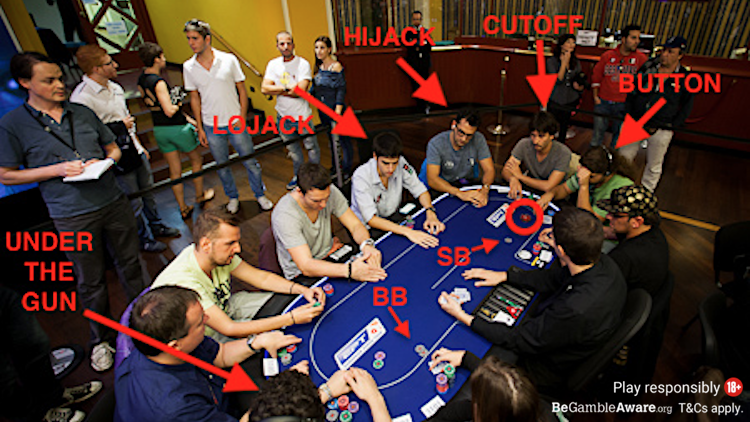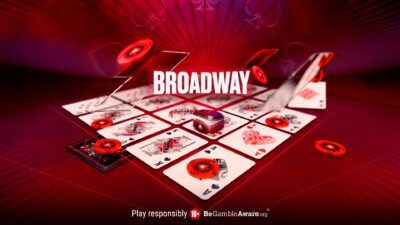One aspect of poker that new players don’t necessarily appreciate at first is the importance of position.
Being able to act after your opponent gives you a huge advantage, since you have the added information of knowing what your opponent has done before you have to decide what to do yourself.
It makes sense, then, that most strategy advice suggests you try to play more hands from late position than from early position. In some cases position can even matter more than your cards or the size of the chip stacks.
Position is important in all poker games, though especially in games that feature no-limit or pot-limit betting. In those games individual bets can get quite big, which means players in later positions can put serious pressure on those in early positions.
In “flop games” like no-limit hold’em and pot-limit Omaha, the seats around the table all have particular names that refer to their position. New players should become familiar with these poker seat names early in their poker education, Indeed, learning seat names should be among the very first poker definitions new players learn.
Along with learning those seat names, players need to understand some of the common strategies associated with each position around the table.
Small Blind
The players seated in the two seats left of the dealer are called the “small blind” and “big blind.” The seats are named for the “blind” bets players are required to make before ever seeing their cards.
Of the two seats, players should be much less willing to play hands from the small blind. After the flop, you will have to act first on every betting round, meaning everyone else in the hand will have a positional advantage.
Big Blind
By contrast, you will find it necessary to “defend” your big blind against late position raises from time to time. Sometimes you’ll have a big hand yourself and want to reraise or three-bet when facing a raise. Other times you’ll want to call.
That said, don’t always feel obligated to play hands from the big blind just because you’ve already contributed chips to the pot. Again, you’ll likely be in early position postflop and thus at a disadvantage. Statistically speaking, players lose more chips from the big blind than from any other position. Don’t make that situation worse by playing too many hands from the big blind.
Under the Gun
The seat to the left of the big blind is called “under the gun” because that player is the very first to act after the cards are initially dealt. Being under the gun or “UTG” is also a disadvantageous position, only in this case players can fold without losing any blinds.
You should probably never limp from UTG as doing so only invites players with a positional advantage from joining in. Raising from UTG is a sign of extreme strength usually only done with the strongest of hands.
Middle Position
Moving around the table, “middle position” refers to the next seat or two to the left of under the gun. Here, too, players should be selective about the hands they choose to play. Entering the pot with a raise is recommended, as ideally you knock out others seated behind you and enjoy positional advantage postflop.
Know, however, that with multiple late position seats to come, when you raise from middle position you will often get a caller who will have position on you postflop. That isn’t the worst of situations, especially when your hand is strong, but will likely require caution as the hand proceeds.
Lojack
The “lojack” refers to the seat to the right of the hijack. There are two players between the lojack and the button or dealer position. Now we are moving into the category of late position seats, and a preflop raise from the lojack can sometimes clear out remaining late-position players to ensure the lojack gets postflop positional advantage.
Even so, the lojack is still more or less a middle-position seat. Many players will approach it similarly and be selective about entering pots from this seat. That’s true of online poker strategy and when playing live.
Hijack
The “hijack” seat is left of the lojack, right of the cutoff. It is called the “hijack” because players who raise from this seat are “hijacking” or seizing the privilege of enjoying late-position advantage postflop. Sometimes a raise from the hijack is called “stealing the button” (or an attempt to do so), a nod to the idea of hijacking a car or plane and taking over the direction where a hand goes.
You can be a little more liberal with the hands you play from the hijack than from early and middle position seats. Know, though, that the cutoff or button can still reraise and thwart your plans.
Cutoff
The “cutoff” is the seat immediately to the right of the button. Its name is similar to the hijack in that it indicates what happens when a player raises from this seat — the player “cuts off” the button and takes away the button’s positional advantage. (Again, a cutoff raise is sometimes called “stealing the button.”)
You can raise or even reraise with a variety of hands from the cutoff. Even medium-strength or weaker hands can be raised, since the pressure you can exert on players having to act from earlier positions can be so important.
Button
The “button” is the best seat at the poker table. For most players, the button is the most profitable position from which to play hands. For that reason, you should try to play a higher percentage of hands from the button than from any other seat.
If it folds around to you on the button, you can often raise with almost any hand in order to “steal the blinds.” (Of course, know the tendencies of those players in the blinds, as they might not be so quick to back down to your raise.) You can also call others’ raises and enjoy positional advantage postflop in an already building pot.
Again, being able to act last means having added information every time you act postflop. It also enables you to pressure opponents more often, bluffing them and making it hard for them to continue without very strong hands.
Positional awareness is a big part of any successful poker strategy.
Back to Top







